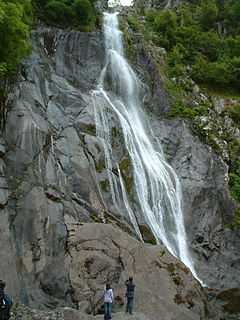Afon Rheidol
The Afon Rheidol (English: River Rheidol) is a river in Ceredigion, Wales. The length of the main river is 31 km (19 miles). Its catchment area covers 189 km2 (73 square miles) and receives an average annual rainfall of 1015 mm (40 inches).[1]
Geography and geology
The Rheidol rises in the headwaters of the Nant y Moch reservoir (52°27′32″N 3°50′06″W / 52.4590°N 3.8349°W) on the western flanks of Plynlimon, near the sources of the Wye and Severn. It then flows south through the village of Ponterwyd on the main Aberystwyth to Rhayader road. Continuing south-westwards, largely through Welsh Oak ancient woodlands in an increasingly deep valley the Rheidol joins with the Afon Mynach and veers westwards, the direction in which it continues for most of the rest of its course. At its confluence with the Mynach, it descends one of the most spectacular waterfalls in Wales at Pontarfynach (Devil's Bridge). Below these waterfalls, the river passes the abandoned workings of the Cwm Rheidol lead mine. This mine, together with numerous other metal mines in the valley, has been a source of extreme metal pollution of the river right down to the sea. Even when the mine was closed, a major blowout of water contained in an adit in the late 1960s coloured the whole river an ochre orange colour and greatly added to the concentrations of lead and zinc in the river. Management of the waters still draining from the mine is by the use of constructed wetlands. Previous management includes a limestone filter bed, installed in the 1960s, which is now redundant. The filter bed is still in place and can be seen from the road. The remainder of the meandering course of the river is through an ever-widening valley before discharging to the sea through Aberystwyth (52°24′26″N 4°05′23″W / 52.4071°N 4.0898°W).
Environment
The catchment of the Rheidol is dominated by the western maritime exposure of this part of Wales. Rainfall levels are high and ecosystems reflect both high rainfall and the acidic nature of the underlying rocks. Combined with the acid mine drainage from abandoned silver and lead mines that sit within the catchment (the area around Aberystwyth contains 38 of the 50 worst polluting metal mines in Wales),[2] by 1991 the river had regularly broken EEC pollution limits for heavy-metal contamination such as zinc.[3]
Upland Molinia spp. grassland is common growing on deep deposits of peat. Within the valleys, dense and ancient oak forests with rich understoreys of ferns, mosses and lichens are common. In the valley bottom, glacial and alluvial deposits have been worked by man into a relatively low intensive agriculture.

Economy and the human influence
Metal mining dominated the economy of the Rheidol valley for many centuries. Mining has now been replaced by farming (beef, dairy and sheep), forestry and tourism.
There are a number of tourist attractions in the Rheidol valley. These include the Devil's Bridge waterfalls where three bridges, each built over the previous, span the top of a most spectacular waterfall.
Between Devil's Bridge and Aberystwyth runs a narrow-gauge steam railway - the Vale of Rheidol Railway. This was originally built to ship metal ore from the mines but now provides a very popular tourist route into the top end of the Rheidol valley.
A large stag shape on the valley wall is a scheduled ancient monument and is one of two stags hill figures in the United Kingdom, the other being at Mormond Hill in Scotland. But it is in fact a lead mining waste feature which merely resembles a stag and is not a true hill figure.[4]
References
- ↑ Brooker M.P. & Morris D.L.: A survey of the macroinvertebrates of the Rivers Ystwyth and Rheidol
- ↑ Environment Agency, 2002, in Pearce, Hartley, Perkins, Dinelli et al., 2007
- ↑ Ronald Fuge, Ian M. S. Laidlaw, William T. Perkins and Kerry P. Rogers, Ronald; Laidlaw, Ian M. S.; Perkins, William T.; Rogers, Kerry P. (1991). "The influence of acidic mine and spoil drainage on water quality in the mid-Wales area". Environmental Geochemistry and Health 13 (2): 70–75. doi:10.1007/BF01734297.
- ↑ "WHITE STAG, RHEIDOL VALLEY" at coflein.gov.uk
Coordinates: 52°23′28″N 3°57′04″W / 52.391°N 3.951°W
| ||||||||||||||||||||

